Related Research Articles
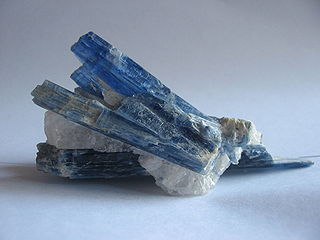
Kyanite is a typically blue aluminosilicate mineral, found in aluminium-rich metamorphic pegmatites and sedimentary rock. It is the high pressure polymorph of andalusite and sillimanite, and the presence of kyanite in metamorphic rocks generally indicates metamorphism deep in the Earth's crust. Kyanite is also known as disthene or cyanite.
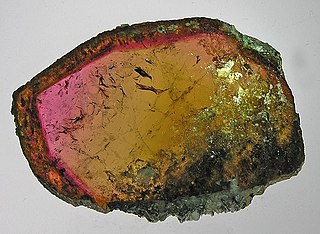
Tourmaline is a crystalline silicate mineral group in which boron is compounded with elements such as aluminium, iron, magnesium, sodium, lithium, or potassium. This gemstone comes in a wide variety of colors.

A pegmatite is an igneous rock showing a very coarse texture, with large interlocking crystals usually greater in size than 1 cm (0.4 in) and sometimes greater than 1 meter (3 ft). Most pegmatites are composed of quartz, feldspar, and mica, having a similar silicic composition to granite. However, rarer intermediate composition and mafic pegmatites are known.
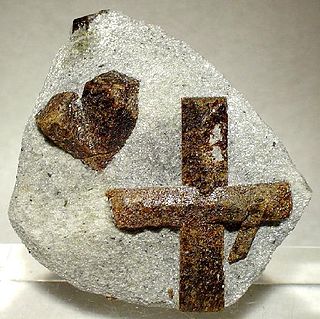
Staurolite is a reddish brown to black, mostly opaque, nesosilicate mineral with a white streak. It crystallizes in the monoclinic crystal system, has a Mohs hardness of 7 to 7.5 and the chemical formula: Fe2+2Al9O6(SiO4)4(O,OH)2. Magnesium, zinc and manganese substitute in the iron site and trivalent iron can substitute for aluminium.
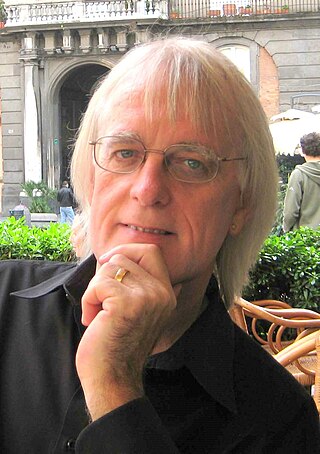
Frank Christopher Hawthorne is a Canadian mineralogist, crystallographer and spectroscopist. He works at the University of Manitoba, Winnipeg, Manitoba, Canada, and is currently Distinguished Professor Emeritus. By combining Graph Theory, Bond-Valence Theory and the moments approach to the electronic energy density of solids he has developed Bond Topology as a rigorous approach to understanding the atomic arrangements, chemical compositions and paragenesis of complex oxide and oxysalt minerals.
W. Gary Ernst is an American geologist specializing in petrology and geochemistry. He currently is the Benjamin M. Page Professor Emeritus in Stanford University's department of geological sciences.

Fluor-buergerite, originally named buergerite, is a mineral species belonging to the tourmaline group. It was first described for an occurrence in rhyolitic cavities near Mexquitic, San Luis Potosi, Mexico. It was approved as a mineral in 1966 by the IMA and named in honor of Martin J. Buerger (1903–1986), professor of mineralogy at the Massachusetts Institute of Technology. It has also been reported from Minas Gerais, Brazil, and the Central Bohemia Region of the Czech Republic.
Stuart Olof Agrell was an optical mineralogist and a pioneer in applications of the electron microprobe to petrology. His involvement as a principal investigator in the analysis of Moon rocks collected in the Apollo program brought him to the attention of the British media and public.
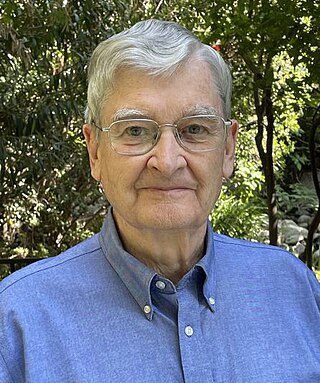
George R. Rossman is an American mineralogist and the Professor of Mineralogy at the California Institute of Technology.
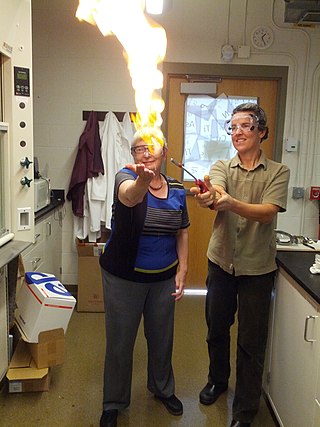
Alexandra Navrotsky is a physical chemist in the field of nanogeoscience. She is an elected member of the United States National Academy of Sciences (NAS) and the American Philosophical Society (APS). She was a board member of the Earth Sciences and Resources division of the NAS from 1995 until 2000. In 2005, she was awarded the Urey Medal, by the European Association of Geochemistry. In 2006, she was awarded the Harry H. Hess Medal, by the American Geophysical Union. She is currently the director of NEAT ORU, a primary program in nanogeoscience. She is distinguished professor at University of California, Davis.
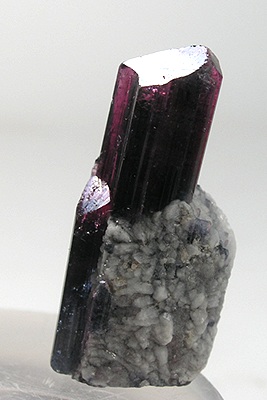
Fluor-liddicoatite is a rare member of the tourmaline group of minerals, elbaite subgroup, and the theoretical calcium endmember of the elbaite-fluor-liddicoatite series; the pure end-member has not yet been found in nature. Fluor-liddicoatite is indistinguishable from elbaite by X-ray diffraction techniques. It forms a series with elbaite and probably also with olenite. Liddiocoatite is currently a non-approved mineral name, but Aurisicchio et al. (1999) and Breaks et al. (2008) found OH-dominant species. Formulae are

Bernard Elgey Leake is an English geologist. He is Emeritus Professor of Geology at the University of Glasgow, was Leverhulme Emeritus Fellow at Cardiff University 2000-2002 and has been an Honorary Research Fellow at Cardiff University since 1997.

Timothy John Barrington Holland is a petrologist and Emeritus Professor in the Department of Earth Sciences at the University of Cambridge.

A petrogenetic grid is a geological phase diagram that connects the stability ranges or metastability ranges of metamorphic minerals or mineral assemblages to the conditions of metamorphism. Experimentally determined mineral or mineral-assemblage stability ranges are plotted as metamorphic reaction boundaries in a pressure–temperature cartesian coordinate system to produce a petrogenetic grid for a particular rock composition. The regions of overlap of the stability fields of minerals form equilibrium mineral assemblages used to determine the pressure–temperature conditions of metamorphism. This is particularly useful in geothermobarometry.
Rebecca Ann Lange is a professor of experimental petrology, magmatism and volcanism at the University of Michigan. Her research investigates how magmatism has shaped the evolution of the Earth, as well as the formation of continental crust. She is a Fellow of the Mineralogical Society of America and was awarded the F.W. Clarke Medal in 1995.
Melinda Darby Dyar is a planetary geologist, mineralogist, and spectroscopist whose research relates to the evolution of the Solar System. She studies the redox state of iron and the abundance of hydrogen using Mössbauer, x-ray absorption, and FTIR spectroscopy in the Solar System planets, specifically Earth, Moon, Mars, Mercury, and Venus.
Jane Selverstone is a geologist known for her research into tectonic processes, especially as they apply to the Eastern Alps.
Daniele Cherniak is an American geochemist known for her work on using particle beams for geochemical analysis on small scales. She was elected a fellow of the American Geophysical Union in 2021.
James Burleigh Thompson Jr. was an American mineralogist and geologist. He was known for his research into the thermodynamics of minerals and the relationship to structure. He introduced the term polysomatic series for describing layered structures with chemically distinct layers.
Charles Thompson Prewitt was an American mineralogist and solid state chemist known for his work on structural chemistry of minerals and high-pressure chemistry.
References
- 1 2 3 4 5 "Love of rocks leads to rewarding career for Chadron native". www.csc.edu. Retrieved 2021-07-02.
- ↑ "Barbara Dutrow". Louisiana State University . Archived from the original on 2015-08-22.
- ↑ Dutrow, Barbara Lee (1980). Metric analysis of a late pleistocene mammoth assemblage, Hot Springs, South Dakota (Thesis). OCLC 8934931.
- ↑ Dutrow, Barbara Lee (1985). A staurolite trilogy: 1. Lithium in staurolite and its petrologic significance. 2. An experimental determination of the upper stability of staurolite plus quartz. 3. Evidence for multiple metamorphic episodes in the Farmington Quadrangle, Maine (Thesis). Dallas, Tex. OCLC 753798762.
- ↑ "Mineralogical Society of America - 2021 MSA Committees And Appointed Posts". www.minsocam.org. Retrieved 2021-07-02.
- ↑ Mathews, Jacob. "Recently discovered mineral in Italy named after LSU professor". The Reveille. Retrieved 2021-07-02.
- ↑ "New Mineral Named in Honor of Barbara Dutrow". Elements. 2020-04-02. Retrieved 2021-07-02.
- 1 2 "GSA Officers & Councilors". www.geosociety.org. Retrieved 2021-07-02.
- ↑ "LSU: Geological Society of America Fellows". Archived from the original on 2016-04-01.
- ↑ "Awards & Scholarships - List of MSA Fellows". Microscopy Society of America. Retrieved 2021-07-02.